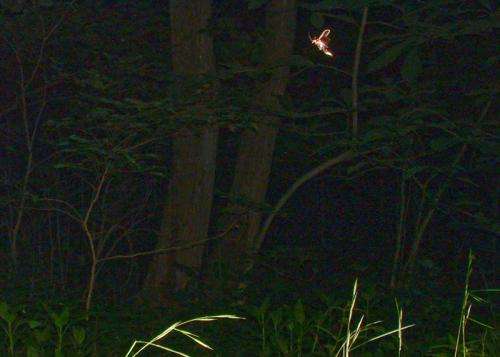Why fireflies blink in synch

For decades, scientists and the public alike have wondered why some fireflies exhibit synchronous flashing, in which large groups produce rhythmic, repeated flashes in unison – sometimes lighting up a whole forest at once.
Now, UConn’s Andrew Moiseff, a professor in the Department of Physiology and Neurobiology in the College of Liberal Arts and Sciences, has conducted the first experiments on the purpose of this phenomenon. His results, reported in the journal Science, suggest that synchronous flashing encourages female fireflies’ recognition of suitable mates.
“There have been lots of really good observations and hypotheses about firefly synchrony,” Moiseff says. “But until now, no one has experimentally tested whether synchrony has a function.”
Moiseff has had an interest in fireflies since he was an undergraduate at Stony Brook University. There he met his current collaborator, Jonathan Copeland of Georgia Southern University, who was a graduate student at the time. When the two graduated, Moiseff moved on to pursue other research interests. But in 1992, Copeland received an enlightening phone call.
“He had commented in a paper that firefly synchrony was rare, and mostly seen in southeast Asia,” says Moiseff. “But a naturalist from Tennessee called him to say that each summer the fireflies at her summer cabin all flashed at the same time.”
Moiseff and Copeland flew down to the Great Smoky Mountains National Park to check out the fireflies and, says Moiseff, they’ve been going back every year since.
Fireflies – which are actually a type of beetle – produce bioluminescence as a mating tool, in which males display a species-specific pattern of flashes while “cruising” through the air, looking for females, says Moiseff. These patterns consist of one or more flashes followed by a characteristic pause, during which female fireflies, perched on leaves or branches, will produce a single response flash if they spot a suitable male.
Of the roughly 2,000 species of fireflies around the world, scientists estimate that about 1 percent synchronize their flashes over large areas. Thousands of male fireflies may blink at once, creating a spectacular light show. In their current study, Moiseff and Copeland wondered what evolutionary benefit this species gains from synchronous flashing.
The two hypothesized that males synchronize to facilitate the females’ ability to recognize the particular flashing pattern of their own species. To test this theory, they collected females of the synchronous species Photinus carolinus from the Smoky Mountains National Park and exposed them in the laboratory to groups of small blinking lights meant to mimic male fireflies. Each individual light produced the P. carolinus flashing pattern, but the experimenters varied the degree to which the flashes were in synch with one another.
“We had the technology to design something that we thought would create a virtual world for these females,” says Moiseff.

Their results showed that females responded more than 80 percent of the time to flashes that were in perfect unison or in near-perfect unison. But when the flashes were out of synch, the females’ response rate was 10 percent or less.
Since synchronous species are often observed in high densities, Moiseff and Copeland concluded that their results suggest a physiological problem in the females’ information processing. Male fireflies are typically in flight while searching for females, so their flashes appear in different locations over time. Therefore, says Moiseff, females must be able to recognize visual cues over a large area.
But, he points out, this behavior presents a problem in areas crowded with male fireflies. Instead of seeing a single flying male, the female would see a cluttered landscape of flashes that could be individually unrecognizable.
“When males are flashing in high densities, the female’s inability to focus on just one male would make it very difficult for her to detect her species-specific pattern,” Moiseff says. “So if the males synchronize, it can maintain the fidelity of the signal in the presence of many other males.”
Whether the females can’t or simply choose not to discriminate spatial information on small scales is unclear, says Moiseff. His future research will focus on questions that address whether physiological constraints or behavioral decisions are driving the evolution of synchrony.
Overall, says Moiseff, he is interested in the role that animal physiology plays in shaping evolution.
“Animals have evolved to solve unique problems in many different ways, and I’m interested in how they do that,” he says. “Fireflies have these tiny heads and these tiny brains, but they can do some complex and amazing things.”
More information: www.sciencemag.org/cgi/content … bstract/329/5988/181
Provided by University of Connecticut


















